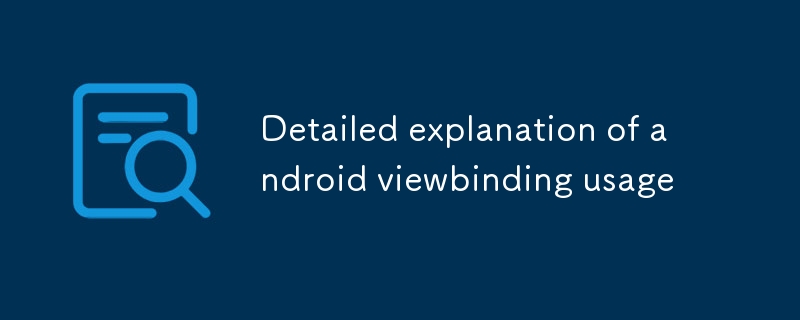This article discusses performance optimizations for Android View Binding. It highlights techniques to minimize inflate operations, cache inflated views, use synthetic constructors, and leverage '' tags. It also explores advant

Optimizing Android View Binding for Performance
To optimize Android View Binding for performance, consider the following techniques:
- Avoid binding inflate operations in loops:Inflate operations can be expensive, so avoid calling
inflate()multiple times for the same layout. Instead, store the inflated object in a variable and reuse it as needed.
- Cache inflated views:Once a view is inflated, cache it and reuse it instead of inflating it multiple times. This is especially beneficial for views that require complex initialization or are frequently displayed.
- Use synthetic constructors:Android Studio can generate synthetic constructors for views, which can improve performance and reduce compile times. Enable synthetic access in your project's
gradle.propertiesfile by settingandroid.enableSelfDestruct=true.
- Consider using
Advantages and Disadvantages of Android View Binding
Advantages:
- Improved code safety:View binding eliminates the need for findViewById() calls, reducing the risk of NullPointerExceptions and providing compile-time safety.
- Simplified code:View binding generates boilerplate code automatically, simplifying the layout process and reducing the amount of code you need to write.
- Enhanced performance:Compared to traditional findViewById() calls, view binding inflates layouts faster and avoids costly reflective calls.
Disadvantages:
- Increased binary size:View binding generates additional class files for each layout, which can increase the size of your APK.
- Limited flexibility:View binding is strongly tied to specific layouts, making it less flexible than manual findViewById() calls.
- Potential performance issues:Inflating complex layouts with many nested views can still lead to performance issues, even with view binding.
Handling Complex View Hierarchies with Android View Binding
To handle complex view hierarchies with Android View Binding:
- Use nested binding:Create a binding class for each child view and then nest them within a parent binding class. This allows you to access child views in the parent view's binding object.
- Split large layouts into fragments:If you have a particularly large or complex layout, consider splitting it into multiple fragments. This can improve performance and make it easier to manage.
- Utilize view binding delegates:Consider using libraries like ViewBindingDelegate or ButterKnife to delegate the creation of bindings to a separate class. This can help with performance and organization.
Ce qui précède est le contenu détaillé de. pour plus d'informations, suivez d'autres articles connexes sur le site Web de PHP en chinois!


 Comment utiliser le survol en CSS
Comment utiliser le survol en CSS Introduction aux noms de domaine de premier niveau couramment utilisés
Introduction aux noms de domaine de premier niveau couramment utilisés La différence entre HTML et HTML5
La différence entre HTML et HTML5 Comment utiliser le code js
Comment utiliser le code js Quelles sont les nouvelles fonctionnalités de Hongmeng 3.0 ?
Quelles sont les nouvelles fonctionnalités de Hongmeng 3.0 ? Comment calculer la factorielle d'un nombre en python
Comment calculer la factorielle d'un nombre en python que signifie l'élan
que signifie l'élan Raisons pour lesquelles phpstudy ne peut pas être ouvert
Raisons pour lesquelles phpstudy ne peut pas être ouvert